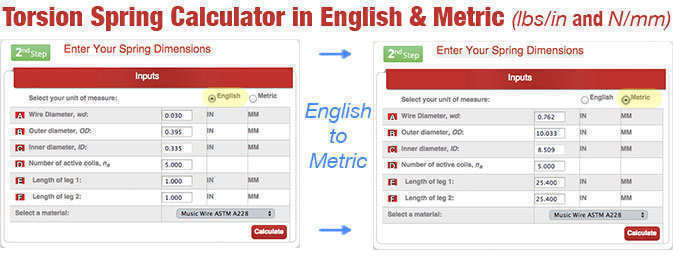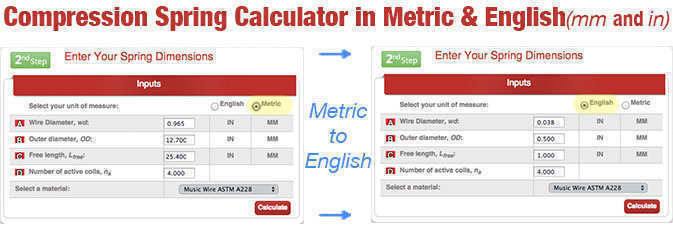Spring Rate Calculator in English and Metric
Attention! Input results shown will be +/- 10% from middle value. Hint: The closer your min and max inputs are, the more accurate your results will be!
Attention! Input results shown will be +/- 10% from middle value. Hint: The closer your min and max inputs are, the more accurate your results will be!
Attention! Input results shown will be +/- 10% from middle value. Hint: The closer your min and max inputs are, the more accurate your results will be!
Definition: Spring calculator software which is able to calculate spring rate in both the english (lbs/in) and metric (N/mm) units of measurement.
Calculate and generate a spring design from the ground up using our spring rate calculator in either the english or metric units of measurement. In the english system of measurement, the units used include inches (in.) and pounds of force (lbs. / lbf.). The metric system of measurement, on the other hand, uses millimeters (mm) and newtons (N).
The calculator isn't only able to calculate your spring's rate and other dimensions in both units of measurement but it will also automatically convert from inches to millimeters and vice versa when you select the opposite option to the one you already have selected. For example: if the inputs are in the english units of measurement and you click on the option at the top that says “Metric”, the dimensions will automatically convert to millimeters without having to click on anything else. You may confirm these dimensions by multiplying the inch value by 25.4 or dividing the millimeter value by 25.4.
Conversion Formulas:
Inches to Millimeters
in x 25.4 = mm
Example:
*Wire Diameter
0.03 x 25.4 = 0.762
*Outer Diameter
0.395 x 25.4 = 10.033
Inner Diameter
0.03 x 25.4 = 8.509
Leg Lengths
1 x 25.4 = 25.4

Spring Creator will work with compression, extension, and torsion spring designs and you will have the opportunity to calculate in either the english or metric units of measurement for either type of spring.
For compression springs, the required inputs in either inches or millimeters include wire diameter, outer diameter, free length, and active coils. It will calculate values like rate, maximum travel considering solid height, and maximum load considering solid height.
For extension springs, the required inputs are wire diameter, outer diameter, and length inside hooks. When you click on calculate, the results will include spring rate, initial tension, maximum safe travel considering hook stress, and maximum load possible considering hook stress.
The calculation of a torsional spring requires a bit more of information like wire diameter, outer diameter, total coils, and leg lengths 1 and 2 to calculate spring rate per degree, spring rate per 360 degrees, safe maximum deflection, and safe maximum torque.
Conversion Formulas:
Millimeters to Inches
mm ÷ 25.4 = in
Example:
*Wire Diameter
0.965 ÷ 25.4 = 0.038
*Outer Diameter
12.7 ÷ 25.4 = 0.5
*Free Length
25.4 ÷ 25.4 = 1






